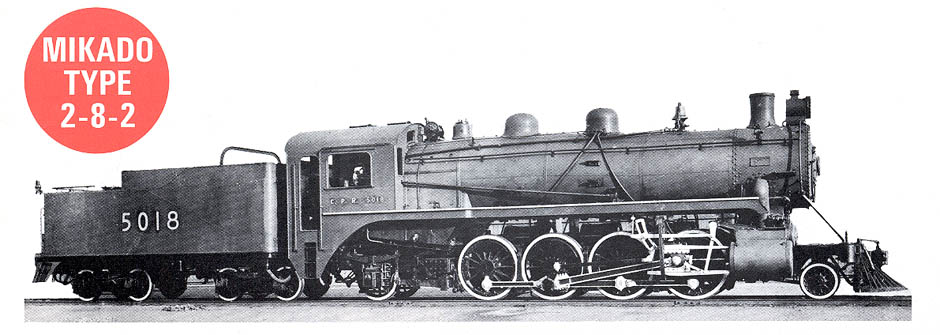Collectors' Item 14
by Omer Lavallee
In the evolution of the
steam locomotive, effort was directed to produce an ever more powerful mechanism, within
the fixed conventions of height and width peculiar to railways.
One of the limiting factors in a steam locomotive's ability to travel
quickly was the rate at which its boiler could generate steam. As long as speeds remained
low, comparatively small boilers sufficed, but as the demand for improved speeds arose with
advances in track and roadbed, greatly enlarged boilers became necessary. Boilers were
therefore made longer, and the additional length accommodated on a swivelling trailing
truck placed under the firebox, the latter no longer confined to the narrow space between
the driving wheels.
While trailing trucks began to make their appearance under passenger
engines on Canadian Pacific lines as early as 1905, the large number of 2-8-0
type engines in freight service postponed development of a large-boilered
freight locomotive until 1912. In that year the first 2-8-2 locomotives
were
|
produced (class P1a) and while they had
the same tractive effort as N2 class 2-8-0s then still being produced, their
larger boilers meant faster steam generation and hence, higher speeds. The era of the fast
freight train had come, and in spite of evolution toward a "super" locomotive
which manifested itself in the 1920s and 1930s, the 2-8-2 remained the basic
road freight locomotive to the end of the steam era, certainly on Canadian Pacific lines.
In all, 334 2-8-2s served the Company. Their American type
name "Mikado", incidentally, was related to the fact that some 2-8-2s
built for the Imperial Government Railways of Japan were said to be the first of their wheel
arrangement ever outshopped.
Canadian Pacific's units proved to be most reliable and versatile
engines; the light P1, illustrated above, was equally at home on passenger trains in hilly
terrain. Between 1926 and 1930, the ninety-five P1s were rebuilt with smaller
diameter cylinders and higher boiler pressures; as each locomotive was converted, 100 was
added to the road number. Thus, No. 5018 illustrated above eventually became No.
5118.
|
|
SPECIFICATIONS
Class
Numbers
Builder
Year
Cylinders (Dia x stroke)
Drivers (Dia)
Pressure (psi)
Weight (Lbs)
* Rebuilt in 1946-49 from N2 class 2-8-0 type.
|
P1a
rebuilt to
P1d
5000-19
later
5100-19
Angus
1912
23.5 x 32
later
23 x 32
63
180
later
190
457,500 to
|
P1b
rebuilt to
P1e
5020-94
later
5120-94
MLW
1913
23.5 X 32
later
23 x 32
63
180
later
190
518,000
|
P1n
5200-64 *
Various
1910-13
22 x 32
63
215
509,000
|
|
